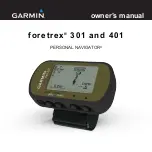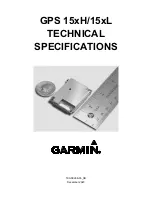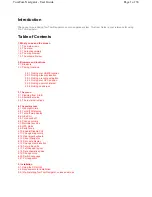
WinFrog User’s Guide - Appendix C – GPS/MX 9400
Page 15 of
22
GDOP
– Geometric Dilution of Precision. GDOP is a numerical value that serves as
a measure of the effect of the satellite constellation’s geometry on the derived
positional accuracy. In other words, the GPS receiver’s measurement accuracy is
multiplied by the GDOP value to derive the overall positional accuracy of the GPS
receiver (including the three positional dimensions and clock offset). If the GDOP
mask is set to On and the calculated GDOP exceeds the entered value, WinFrog will
not compute a position solution using pseudoranges. If the Calculations window is
enabled, an alarm will sound to indicate that the GDOP has been exceeded.
VDOP
–
Vertical Dilution of Precision. This parameter is also calculated from satellite
geometry and gives an indication of the expected accuracy of the vertical component
of the GPS position solution. If the VDOP mask is set to On and the calculated
VDOP exceeds the entered value, WinFrog will automatically initiate 2D or fixed
height mode using either the last valid calculated height or the height entered in the
Antenna Height
Ellipsoid Height
field. If the Calculations window is enabled, an
alarm will sound to indicate that the VDOP has been exceeded.
Elev. Cutoff
– (Elevation Angle Cutoff). WinFrog will not use measurements from
any satellites with elevation angles below the angular value input in the Elevation
Angle Cutoff field. Any satellites not used in the pseudorange position calculations
are indicated in the Calculations window by a change of color.
Min SN
–
Minimum Signal to Noise. This field is used to set the minimum signal to
noise ratio for the pseudorange calculations. If a satellite’s signal to noise ratio falls
below the entered value, the satellite will not be used in position computation by
WinFrog. Satellites not used in the position computation due to low signal to noise
values are indicated in the Calculations window by a change of color.
Max Res
–
Maximum Measurement Residual. WinFrog will not use any satellite
measurement with a residual greater than the Maximum Measurement Residual in
its pseudorange position computations. Satellites not used in the position
computation due to measurement residuals are indicated in the Calculations window
by a change of color.
Max RTCM Age
–
Maximum RTCM Differential Correction Age. This parameter sets
the maximum latency of real time differential corrections for pseudoranges. If the
maximum latency is exceeded, WinFrog will not apply the corrections from that
RTCM source. To indicate this condition, the
STAT
light in the Position
portion of the
Calculations window will turn yellow. Click on the
ACK
button to acknowledge this
alarm.
Test:
Click this button to open the
GPS Solution Statistical Testing
dialog box, as seen
below.








































